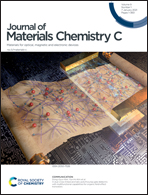Chalcogen-vacancy group VI transition metal dichalcogenide nanosheets for electrochemical and photoelectrochemical hydrogen evolution†
Abstract
Solar photoelectrochemical water splitting using the catalytic hydrogen evolution reaction (HER) is one of the most promising methods for producing hydrogen energy. Herein, we report the facile synthesis of chalcogen vacancy-rich (5–20%) transition metal dichalcogenide (TMD, i.e., MoS2, MoSe2, WS2, and WSe2) nanostructures for the (photo)electrocatalytic HER. Atomically resolved scanning transmission electron microscopy revealed the concentration of chalcogen (S and Se) vacancies, as well as the formation of double chalcogen vacancies at higher concentrations. Photocathodes consisting of a Si nanowire array sheathed in TMD layers exhibited excellent photoelectrocatalytic performance under AM 1.5 irradiation conditions. The photocurrent reached 30 mA cm−2 (at 0 V vs. RHE) with a high faradaic efficiency (90%) and negligible degradation of the HER for 3 h. The free-standing TMD nanosheets exhibit excellent electrocatalytic HER performance (an overpotential of 162–202 mV vs. RHE for 10 mA cm−2 and a Tafel slope of 70–84 mV dec−1 in 0.5 M H2SO4), which can be correlated with the vacancy concentration. A detailed structural analysis suggested that the chalcogen vacancies play a major role in determining the catalytic activity toward the HER, which in turn is responsible for the enhanced PEC performance.

- This article is part of the themed collection: Journal of Materials Chemistry C HOT Papers


 Please wait while we load your content...
Please wait while we load your content...